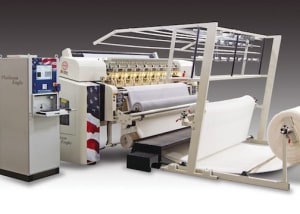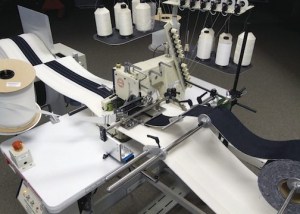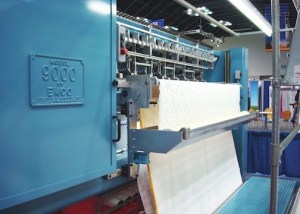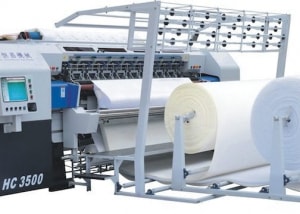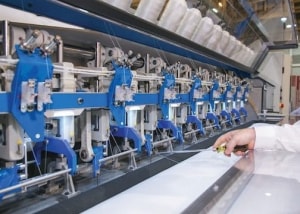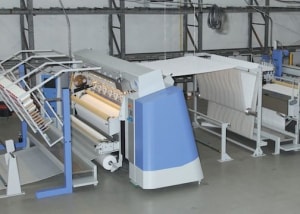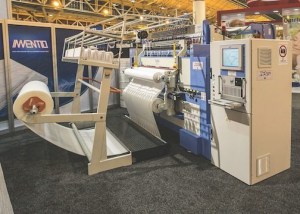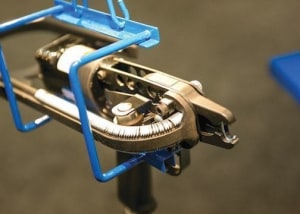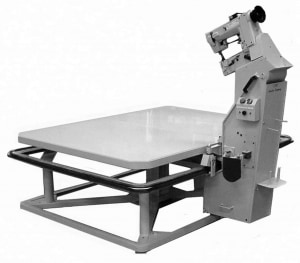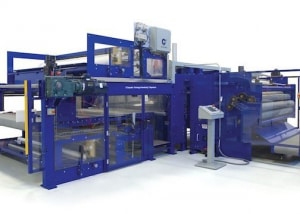Machines and automation are by nature designed to make life simpler—to give you the ability to make things faster, better, cheaper and more consistently—and the wide range of specialized equipment in the mattress industry these days is staggering. Machinery suppliers are listening to what their customers want, providing equipment that consistently improves speed or functionality, and innovating in response to the changing face of today’s bedding.
Many of the newest machines made their debut at ISPA EXPO in New Orleans in March.
“At ISPA EXPO this year, the market came in with a lot more optimism than it has had in many years—since the economic slump in 2008 and 2009,” says Michael Miller, president of domestic sales and market development at Leggett & Platt’s Global Systems Group. “People were looking for something innovative—something that would set them apart.”
Atlanta Attachment President Hank Little says there was a heightened interest in products at EXPO, and that business is trending up from where it was a year ago.
“We had a good mix of both domestic and international customers at the show, and both were asking a lot of questions about automation and ways to take cost out of the process, and to manufacture in the most efficient way possible,” he says.
- Atlanta Attachment’s 1392P Platinum Eagle features a tilted bed and Pattern “N” Pattern Technology.
- Atlanta Attachment’s 1312K6 Automatic Decorative Border Workstation has been updated to allow for border widths up to 6 inches.
- Brighi’s pillow machine stuffs, sews, compresses and vacuum-seals pillows in rapid-fire time.
- DR Cash’s BT14 Glue Station Build-Up Table is engineered to align the inner components of a foam-encased mattress before the gluing process.
- Edge-Sweets’ new line of HTX precision foam slitters offer enhanced features, including an automated silicon applicator.
- Edgewater’s Emco 9000-3 series can be customized.
- Hengchang’s HC3500 combines a multineedle quilting machine and a single-head quilting machine.
- Leggett & Platt’s Wildstitch technology package promises to make the company’s fast multineedle quilters even faster.
- Mammut’s VMK Select sewing system offers a customized selection of individual sewing positions.
- Meca’s double chain-stitch quilter, Inventio, is capable of producing unique quilt patterns.
- Vertex’s new machine holds 300 hog rings instead of the standard 100, for greater efficiency and productivity.
- James Cash Machine Co. offers the MX-100 The Max tape-edge machine with an adjusting table height.
- C3’s CWU2000, distributed by Atlanta Attachment, operates as two machines in one, roll-packing foam and flat-packing mattresses.
The continued influence of specialty bedding, a heightened focus on border treatments, and demand for more efficient roll-packing and shipping options are all driving innovation and improvements in bedding machinery. And as trends change with lightening-fast speed these days, flexibility of machines and the ability to multitask are becoming even more important characteristics—much like on the human side.
“It used to be that a lifecycle on a bed was two to four years—now sometimes it’s one to two years,” says Little. “Manufacturers are demanding flexibility as much as possible in what they buy.”
Border & tape-edge machines
As mattress tape grows in importance and in design variety (see our story in the June issue of BedTimes, “The Closers,” online at www.bedtimesmagazine.com), the machines that assist in their creation and application have become both more important and more flexible, to accommodate the sheer variety of tape on the market today and the creativity that goes into border treatments.
And as specialty bedding has continued its influence, manufacturers are paying more attention to—and more money for—dressing up their borders.
“The border now is every company’s signature, and so there’s an emphasis on creativity on the border,” says Miller.
Borders are often the first thing consumers see when looking at a mattress, and border aesthetic helps them to make a buying decision.
“It differentiates one mattress from another on the showroom floor,” says Little. “You need something to draw the consumer in.”
Joining two fabrics together, using different colors, textures and types of tape, helps create interest and can mean an almost infinite variety of color combinations. A detailed border also allows manufacturers to differentiate on price, and can help take a bed to a higher price point as well.
Atlanta Attachment’s 1312K6 Automatic Decorative Border Workstation has been updated with a wider needle bar to allow for a larger decorative sew area of 6 inches as compared with the previous, smaller needle bar, and it can also make handles and sew in zippers and/or ribbons on top of the borders.
“The reason for the machine’s popularity is its versatility—customers always like that fact,” says Little. “As looks change, it gives more manufacturing flexibility and a longer life for the capital investment.”
Also getting an update to address changing fashion in border treatments is GSG’s BMS-1500 Border Modular System, from Porter International, which debuted at the 2012 ISPA EXPO with capabilities to produce four unique mattress border styles on a single machine. At this year’s EXPO, GSG increased that number to eight, allowing for a multitude of looks and designs.
GSG’s Mattress Master Optima semi-automated, tape-edge machine, launched last year at Interzum, features belt table movements, a turning arm mechanism and a pneumatic flip device. The Optima can be equipped with a Pfaff sewing head or a 300U style, making it more affordable than other Mattress Masters in the series.
Louisville, Kentucky-based machinery producer James Cash Machinery’s product offerings at EXPO included the MX-100, a popular tape-edge machine that has been re-engineered to adjust for thicker mattress profiles and adjust to a lower height, making it less physically taxing for smaller machine operators.
And after-market machine parts supplier Jumpsource, with dual headquarters in Beverly, Massachusetts, and Shanghai, launched a competitively priced tape-edge machine at EXPO—the company’s first piece of finished equipment.
Packaging and lamination
Another area of importance, given the increase and interest in specialty bedding, is laminating and packaging machines. While laminating machines help glue layers of foam together, the latest in packaging machines focus on compressing those layers for easier transport.
“More and more manufacturers are wanting to take foam beds and compress and roll-pack them to cut shipping costs,” says Little.
When beds are compressed and roll-packed, freight costs go down; Little estimates a manufacturer can load three to four times the amount of foam cores on a truck if they are roll-packed, and save on plastic wrapping costs as well. Add to that the growth in e-commerce, which uses compact, easy-to-ship roll-packed beds, and it’s no wonder the category is on fire.
Atlanta Attachment’s CWU2000 mattress compression wrapper, new in its C3 partnership, roll-packs foam and will flat-pack any mattress. Operating as two machines in one, it reduces costs to e-commerce shipping and can bag 2.5 mattresses per minute, or roll one bed per minute.
At GSG, both the Teknomac TK306 Roll Pack and Merello ME105 packaging machines were demonstrated at ISPA EXPO with new advanced options.
The ME105 now features a film-saving option that can detect whether the staged unit is a low-profile option, like a mattress topper, or a taller item, like a premium mattress. The seal bars can adjust their position to create a better-fitting finished package.
The TK306 was shown with a new lift and box-loading mechanism. This device lifts the finished roll-packed unit into a trough equipped with a push-arm mechanism that can automatically load the finished unit into a shipping box.
“It’s moving production to shipping and to distribution,” says Miller. “And it’s a huge savings on cost.”
Miller says the automated boxing feature was a big hit.
“You can roll, pack and box, all on the same machine—it’s consolidating three operations into one,” he explains.
In glue and lamination machines, the focus is on less mess, eliminating overspray and reducing drying times.
GSG’s GB-1 automated spray adhesive system is a multi-head machine that is ideal for assembling foam-encased or layered foam core units. The company says the GB-1 nearly eliminates overspray and better regulates material consumption and application patterns.
“We’ve automated the process of building foam-encased buckets and laminating foam top layers, reducing the particulation of glue in the air,” says Miller. “There’s less mess, and it’s a more ergonomic, automated process.”
Louisville, Kentucky-based machine manufacturer D.R. Cash Inc. showcased the BT14 Glue Station Build-Up Table at EXPO, engineered to align the inner components of a foam-encased mattress before the gluing process. Engineer Tommy Johnson says the table features a stainless-steel top with expandable length and width to accommodate anything from twin to California king, and includes stainless walls on all four sides. Also highlighted was the company’s THS14 Mattress Bag Heat Sealer, which features an 85-inch seal length and customizable sealing jaw separation (from 6 to 20 inches) to accommodate a broad range of mattress profiles.
Quarrata Forniture, a machinery producer in Quarrata, Italy, came to EXPO with Sahara, a machine designed to quickly dry water-based adhesives so that mattresses can be immediately pressed, packed and rolled up for packing. Also new is the Multiflex foam-encased mattress-gluing machine. Quarrata’s line of machines for mattress production includes a full-roll coating system with conveyer and assembling belts, roll-coating machines and mattress pressers.
Flexibility in quilting
Cologne, Germany-based machinery manufacturer Mammut showed the newly redesigned VMK Select at EXPO, which Managing Director Nikolaus Fremery describes as “the next logical step in the development of powerful multi-needle, double-lock, chainstitch quilting machines.”
The VMK Select sewing system offers a customized selection of individual sewing positions from a depot of sewing system units, both automatic and program-controlled.
“This makes unlimited variations of needle positions possible, either from one quilt pattern to the next, or within a quilt pattern, or both,” says Fremery. “The advantages are an unprecedented variety of quilting patterns and/or split-second changes of any needle settings.”
Fremery says high flexibility, a large variety of pattern options, reliability and minimizing changes over time are the biggest needs he sees in machinery at the moment.
“Our customers have their own client base with increasingly high demands on quality, reliability, flexibility and punctuality at efficient productions costs,” he says. “In order to achieve this, our customers expect a range of machines from us that meets exactly these requirements.”
The newly redesigned VMK Select helps to address several of those needs.
“…It provides our customers the opportunity to stand out among the competition, and to stress the uniqueness of one’s products,” says Fremery.
And, he says, it helps eliminate the changeover time when the needle configuration is changed.
“This has been a main request of our customers in order to execute small orders which otherwise have been unprofitable,” Fremery explains.
Atlanta Attachment’s 1392P Platinum Eagle is a tilted bed, 360-degree, digitally controlled, chainstitch quilting machine that features Pattern “N” Pattern Technology. The tilted base design aids the operator in the change-out of threading of the needles and loopers, and gives better vision of the sewing area. There are also independent presser foot and needle bar drives for right and left sides of the machines.
The Platinum Eagle also boasts sewing speeds up to 1,200 RPM. Loopers have an integral knife blade for thread trimming, and thread tail length is adjustable with software settings, so there is no secondary thread-trimming operation needed.
Atlanta Attachment’s 1342TA quilting repair machine has been updated with an omnidirectional hopping foot.
“It gives you the ability to sew in multi-directions,” says Little. “That’s important if you’re trying to repair a sew and jump pattern in the middle of a panel.”
Automatic thread trimming also ensures a short thread tail once a repair cycle is complete, and requires no additional trimming by hand, which might damage the top panel.
Meca Srl, a 50-year-old maker of multineedle quilting machines, based in Busto-Cassano, Italy, introduced the versatile, double chain-stitch quilter Inventio at EXPO.
“This is the world premier of a new generation of quilting machine,” says Alberto Landoni, Meca chief executive officer. “It’s not better—it’s new and doesn’t exist anywhere else.”
Inventio features the ability to work directly from material rolls to sew up to 13 borders in seven different border patterns at once—and to finish each border or panel edge, eliminating the overlock operation for borders and quilt-tops. The multineedle quilting machine also is capable of producing unique quilt patterns that can combine unusual quilt designs, including mixing straight lines with traditional quilt patterns.
Landoni also says the super-fast machine can produce up to 33,000 feet of finished border in a single shift and works with any fabric or pattern.
College Point, New York-based Edgewater Machine Company introduced its premium Emco 9000 Double Lock Chainstitch Quilter at EXPO. The Emco 9000-3 series boasts Emco’s Compustitch computer system, and can be customized to meet customers’ particular needs. The company also says the Emco 9000 Series are 95% maintenance-free machines, with no oiling points and once-a-month greasing of ball bearings being the only requirement.
Hengchang’s HC3500 is the company’s latest model, and combines a multineedle quilting machine and a single-head quilting machine. This gives customers the flexibility to create intricate patterns, like flowers or logos, on the same machine as they do simple patterns. A state-of-the-art tracking system allows foam to be effortlessly fed into the quilter, the company says.
Leggett & Platt’s GSG launched Wildstitch, a new technology package from Gribitz International, at this year’s EXPO, which promises to make the company’s fast multineedle quilters even faster.
“We’ve created a hardware and software package that allows you to get up to 20% more daily production out of the machine,” says Miller. “…It gives you more horsepower.”
Getting specialized
For every step in the mattress-making production cycle, there is a machine designed to make manufacturers’ lives easier, from cutting foam to creating non-quilted covers to unbaling springs.
Among the successful introductions from 143-year-old Germany-based Fecken-Kirfel, a cutting machine specialist with U.S. offices in Mahwah, New Jersey, was its T6 counter moving blade machine, designed to cut a broad range of high-density viscoelastic foams and latex foams with greater precision and efficiency.
Specializing in custom-engineered foam cutting and dispensing equipment, Grand Rapids, Michigan-based ESCO Group (Edge-Sweets) brought to market new slitting technology for cutting viscoelastic and other high-resilience foams. ESCO’s new line of HTX precision foam slitters offer enhanced features from its previous line of HT slitters. Among the new features is the automated silicon applicator. In addition to a non-stick Teflon coating on the cutting guide, the auto silicone applicator has two independently adjustable spray heads that travel the length of the guide to apply an atomized spray of silicone to the entire length of the top and bottom guide surfaces. This advancement serves as a functional enhancement as well as a safety feature, eliminating the unsafe practice of operators climbing onto machinery to manually apply silicone.
GSG’s Zipcutter is a non-quilted cover-cutting machine that makes it affordable to produce non-quilted, zipper-based covers in-house, cutting a typical queen-size cover with mitered waterfall sides in less that 60 seconds.
“It allows you to take a fully manual process and automate it,” says Miller.
In business for more than 40 years, Forlimpopoli, Italy-based Brighi Tecnologie Italia exhibited at ISPA EXPO for the first time, bringing a fully automated pillow manufacturing and packaging machine that can make 4,000 pillows a shift. The machine stuffs, sews, compresses and vacuum-seals pillows in rapid-fire time, for high productivity and performance.
BEA Fasteners USA, the German company whose U.S. division is based in Greensboro, North Carolina, introduced fastening tools with automated options at EXPO, as well as high-capacity, pre-lubricated magazines that offer mattress producers higher productivity thanks to longer service intervals.
Among new products launched at Vertex, a Des Plaines, Illinois-based division of Leggett & Platt, was a machine that holds 300 hog rings instead of the standard 100, so greater efficiency and productivity results from less reloading. Tools are engineered to be lighter and more ergonomic, to cut down on repetitive motion injuries and reduce strain on operators.
The Chinese machine manufacturer Wuhan Golden Laser introduced its line of laser cutting machines for all kinds of textiles, which the company said provide environmental advantages and save money over the use of traditional blade-style cutting machines. An additional advantage for mattress production is that textile edges are automatically heat-sealed by the laser during the automated cutting process.
At foam-cutting machinery maker Albrecht Bäumer GmbH & Co., with world headquarters in Freudenberg, Germany, the emphasis at EXPO was on automation and updates to existing machinery.
“When it comes to operating software, DOS is over,” says Ron Pugaczewski, sales and key account manager for Bäumer of America, which is based in Towaco, New Jersey. “We’ve upgraded electronics and software across the board.”
Atlanta Attachment’s 1409 Pocket Coil Unbaler for round bales safely unbales roll-packed pocket-spring units, efficiently handling bales up to 28 inches in diameter, wrapped either in paper or fabric. It also rolls up the protective wrap for recycling or easy disposal. Its variable speed 2-HP motor easily handles even the heaviest gauge springs.
“You can dispense them one at a time, which helps manage inventory,” says Little. “This is a machine for any manufacturer who is dealing with pocketed coils.”
Whether it’s a highly specialized machine, or a flexible, multi-functional machine, the bottom line is that mattress machinery makes the manufacturing process easier and more profitable. And flexibility seems to be the key word in that cost-saving process.
Miller at GSG says, “The big focus for us…is being able to automate as much as possible and still be cost-effective, flexible and versatile for the ever-changing market. And to not lose sight of keeping it simple.”

GSG representative David Eidson, left, awards a 50-inch TV to Campbell Mattress Company Plant Manager Fred Knox on the catwalk of the winning machine, a 1983 Gribetz DG 5500.
Campbell Mattress wins oldest Gribetz quilter contest
Cape Giradeau, Missouri-based Campbell Mattress Company was the winner of Global Systems Group’s “Oldest Gribitz Quilter,” a contest held in conjunction with this year’s ISPA EXPO to showcase the durable value of Gribetz equipment.
Contestants were asked to submit serial numbers and photos of their machine; entries were submitted from as far away as Japan, and several models over 25 years old were submitted.
Campbell Mattress continues to operate a Gribetz DG 5500 chainstitch quilter originally shipped in 1983. The company was awarded a 50-inch television.




